Analysis of the First Optical Detection of a Meteoroidal Impact on the Lunar Surface Recorded from Brazil
Abstract
1. Introduction
1.1. Scientific Relevance of Impact Observations
1.2. Observation Campaigns and Amateur Collaboration
1.3. The Geminids Properties
2. Materials and Methods
2.1. Observing Campaign by BRAMON
2.2. Observing Teams, Respective Sites, and Period of Observation
- David Duarte and Romualdo Caldas, in the city of Maceió, in the state of Alagoas, at the geographical coordinates of 9°37′14″S and 35°43′12″W.
- Marcelo Zurita, in the municipality of Araruna, in the state of Paraíba, at the geographical coordinates of 6°27′8″S and 35°40′24″W.
2.3. Observation Circumstances (Orbital, Atmospheric, and Local)
2.3.1. Maceió
2.3.2. Araruna
2.4. Instrumentation
2.4.1. Maceió
2.4.2. Araruna
2.5. Verification for Flash Candidates
3. Results and Discussion
3.1. Identified Flashes
3.2. Confirmation of Lunar Activity Nature
3.3. Positioning on the Lunar Surface
3.4. Photometry
3.4.1. Gamma Value Uniformization
3.4.2. Count Ratio between Mare Crisium and TYC5564-94-1
3.4.3. Count Ratio between the Flashes and Mare Crisium
3.4.4. Light Curves
3.5. Spectral Flux of the Flashes
3.5.1. Spectral Flux of the Comparison Star
3.5.2. Spectral Flux of a Flash
3.5.3. Magnitude Calculation
3.6. Impact Energy, Meteoroid Mass, and Diameter
3.7. Crater Diameter
3.8. On the Geminid Source of the Impactors
4. Conclusions
Supplementary Materials
Author Contributions
Funding
Institutional Review Board Statement
Informed Consent Statement
Acknowledgments
Conflicts of Interest
References
- Oberst, J.; Christou, A.; Suggs, R.; Moser, D.; Daubar, I.J.; McEwen, A.S.; Burchell, M.; Kawamura, T.; Hiesinger, H.; Wünnemann, K.; et al. The present-day flux of large meteoroids on the lunar surface—A synthesis of models and observational techniques. Planet. Space Sci. 2012, 74, 179–193. [Google Scholar] [CrossRef]
- Yanagisawa, M.; Ohnishi, K.; Takamura, Y.; Masuda, H.; Sakai, Y.; Ida, M.; Adachi, M.; Ishida, M. The first confirmed Perseid lunar impact flash. Icarus 2006, 182, 489–495. [Google Scholar] [CrossRef]
- Avdellidou, C.; Munaibari, E.; Larson, R.; Vaubaillon, J.; Delbo, M.; Hayne, P.; Wieczorek, M.; Sheward, D.; Cook, A. Impacts on the Moon: Analysis methods and size distribution of impactors. Planet. Space Sci. 2021, 200, 105201. [Google Scholar] [CrossRef]
- Anderson, B.J. Natural Orbital Environment Guidelines for Use in Aerospace Vehicle Development; NASA Technical Memorandum 4527; NASA Marshall Space Flight Center: Huntsville, AL, USA, 1994. [Google Scholar]
- McNamara, H.; Suggs, R.; Kauffman, B.; Jones, J.; Cooke, W.; Smith, S. Meteoroid Engineering Model (MEM): A Meteoroid Model for The Inner Solar System. In Modern Meteor Science an Interdisciplinary View; Springer: Dordrecht, The Netherlands, 2004; Volume 95, pp. 123–139. [Google Scholar] [CrossRef]
- Ortiz, J.L.; Aceituno, F.J.; Aceituno, J. A search for meteoritic flashes on the Moon. Astron. Astrophys. 1999, 343, L57–L60. [Google Scholar]
- Dunham, D.W.; Cudnik, B.; Palmer, D.M.; Sada, P.V.; Melosh, J.; Beech, M.; Pellerin, L.; Asher, D.; Frankenberger, R.; Venable, R. The first confirmed videorecordings of lunar meteor impacts. Lunar Planet. Sci. 2000, XXXI, 1547. [Google Scholar]
- Ortiz, J.L.; Sada, P.V.; Bellot Rubio, L.R.; Aceituno, F.J.; Aceituno, J.; Gutierrez, P.J.; Thiele, U. Optical detection of meteoroidal impacts on the Moon. Nature 2000, 405, 921–923. [Google Scholar] [CrossRef] [PubMed]
- Yanagisawa, M.; Kisaichi, N. Lightcurves of 1999 Leonid impact flashes on the Moon. Icarus 2002, 159, 31–38. [Google Scholar] [CrossRef]
- Suggs, R.M.; Moser, D.E.; Cooke, W.J.; Suggs, R.J. The flux of kilogram-sized meteoroids from lunar impact monitoring. Icarus 2014, 238, 23–26. [Google Scholar] [CrossRef]
- Madiedo, J.M.; Ortiz, J.L.; Yanagisawa, M.; Aceituno, J.; Aceituno, F. Impact flashes of meteoroids on the moon. In Meteoroids: Sources of Meteors on Earth and Beyond; Ryabova, G.O., Asher, D.J., Campbell-Brown, M.D., Eds.; Cambridge University Press: Cambridge, UK, 2019; pp. 136–158. [Google Scholar] [CrossRef]
- Liakos, A.; Bonanos, A.Z.; Xilouris, E.M.; Koschny, D.; Bellas-Velidis, I.; Boumis, P.; Charmandaris, V.; Dapergolas, A.; Fytsilis, A.; Maroussis, A. NELIOTA: Methods, statistics, and results for meteoroids impacting the moon. Astron. Astrophys. 2020, 633, A112. [Google Scholar] [CrossRef]
- Yanagisawa, M.; Uchida, Y.; Kurihara, S.; Abe, S.; Fuse, R.; Tanaka, S.; Onodera, K.; Yoshida, F.; Chi, H.C.; Lin, Z.Y.; et al. Low dispersion spectra of lunar impact flashes in 2018 Geminids. Planet. Space Sci. 2021, 195, 105131. [Google Scholar] [CrossRef]
- Melosh, H.J. Impact Cratering: A Geologic Process; Oxford University Press: New York, NY, USA, 1989. [Google Scholar] [CrossRef]
- Burchell, M.J.; Cole, M.J.; Ratcliff, P.R. Light Flash and Ionization from Hypervelocity Impacts on Ice. Icarus 1996, 122, 359–365. [Google Scholar] [CrossRef]
- Burchell, M.J.; Kay, L.; Ratcliff, P.R. Use of combined light flash and plasma measurements to study hypervelocity impact processes. Adv. Space Res. 1996, 17, 141–145. [Google Scholar] [CrossRef]
- Bouley, S.; Baratoux, D.; Vaubaillon, J.; Mocquet, A.; Le Feuvre, M.; Colas, F.; Benkhaldoun, Z.; Daassou, A.; Sabil, M.; Lognonné, P. Power and duration of impact flashes on the Moon: Implication for the cause of radiation. Icarus 2012, 218, 115–124. [Google Scholar] [CrossRef]
- Rembold, J.J.; Ryan, E.V. Characterization and Analysis of Near-Earth Objects via Lunar Impact Observations. Planet. Space Sci. 2015, 117, 119–126. [Google Scholar] [CrossRef]
- Madiedo, J.M.; Ortiz, J.L.; Morales, N.; Cabrera-Caño, J. A large lunar impact blast on 2013 September 11. Mon. Not. R. Astron. Soc. 2014, 439, 2364–2369. [Google Scholar] [CrossRef]
- Suggs, R.M.; Ehlert, S.R.; Moser, D.E. A comparison of radiometric calibration techniques for lunar impact flashes. Planet. Space Sci. 2017, 143, 225–229. [Google Scholar] [CrossRef]
- Cudnik, B.M.; Dunham, D.W.; Palmer, D.M.; Cook, A.; Venable, R.; Gural, P.S. The Observation and Characterization of Lunar Meteoroid Impact Phenomena. Earth Moon Planets 2003, 93, 97–106. [Google Scholar] [CrossRef]
- Yamada, R.; Garcia, R.F.; Lognonné, P.; Le Feuvre, M.; Calvet, M.; Gagnepain-Beyneix, J. Optimisation of seismic network design: Application to a geophysical international lunar network. Planet. Space Sci. 2011, 59, 343–354. [Google Scholar] [CrossRef]
- Larbi, M.A.M.; Daassou, A.; Baratoux, D.; Bouley, S.; Benkhaldoun, Z.; Lazrek, M.; Garcia, R.; Colas, F. First Lunar Flashes Observed from Morocco (ILIAD Network): Implications for Lunar Seismology. Earth Moon Planets 2015, 115, 1–21. [Google Scholar] [CrossRef]
- Nakamura, Y.; Latham, G.V.; Dorman, H.J.; Harris, J.E. Passive Seismic Experiment Long Period Event Catalog, Final Version; UTIG Technical Report No. 18; Institute for Geophysics: Austin, TX, USA, 1981. [Google Scholar]
- Lognonné, P.; Le Feuvre, M.; Johnson, C.L.; Weber, R.C. Moon meteoritic seismic hum: Steady state prediction. J. Geophys. Res. 2009, 114, E12. [Google Scholar] [CrossRef]
- Sheward, D.; Cook, A.; Avdellidou, C.; Delbo, M.; Cantarella, B.; Zanatta, L.; Sposetti, S.; Lena, R. Lunar Surface Change Detection with PyNAPLE: The 2017-09-27 Lunar Impact Flash and Impact Crater. Euro-Planet Sci. Congr. 2021, 15, EPSC2021-590. Available online: https://meetingorganizer.copernicus.org/EPSC2021/EPSC2021-590.html (accessed on 25 November 2021).
- Babadzhanov, P.B.; Kokhirova, G.I. Densities and porosities of meteoroids. Astron. Astrophys. 2009, 495, 353–358. [Google Scholar] [CrossRef]
- Kasuga, T.; Jewitt, D. Asteroid-meteoroid complexes. In Meteoroids; Ryabova, G.O., Asher, D.J., Campbell-Brown, M.D., Eds.; Cambridge University Press: Cambridge, UK, 2019; pp. 187–209. [Google Scholar] [CrossRef]
- Abe, S.; Ogawa, T.; Maeda, K.; Arai, T. Sodium variation in Geminid meteoroids from (3200) Phaethon. Planet. Space Sci. 2020, 194, 105040. [Google Scholar] [CrossRef]
- Vaubaillon, J.; Neslusan, L.; Sekhar, A.; Rudawska, R.; Ryabova, G.O. From parent body to meteor shower: The dynamics of meteoroid streams. In Meteoroids; Ryabova, G.O., Asher, D.J., Campbell-Brown, M.D., Eds.; Cambridge University Press: Cambridge, UK, 2019; pp. 161–186. [Google Scholar] [CrossRef]
- Jewitt, D.; Hsieh, H.; Agarwal, J. The active asteroids. In Asteroids IV; Michel., P., De Meo, F.E., Bottke, W.F., Eds.; University Arizona Press: Tucson, AZ, USA, 2015; pp. 221–241. [Google Scholar] [CrossRef]
- Ryabova, G.O. The mass of the Geminid meteoroid stream. Planet. Space Sci. 2017, 143, 125–131. [Google Scholar] [CrossRef]
- Madiedo, J.M.; Ortiz, J.L.; Morales, N.; Cabrera-Caño, J. MIDAS: Software for the detection and analysis of lunar impact flashes. Planet. Space Sci. 2015, 111, 105–115. [Google Scholar] [CrossRef]
- Ortiz, J.L.; Madiedo, J.M.; Morales, N.; Santos-Sanz, P.; Aceituno, F.J. Lunar impact flashes from Geminids: Analysis of luminous efficiencies and the flux of large meteoroids on Earth. Mon. Not. R. Astron. Soc. 2015, 454, 344–352. [Google Scholar] [CrossRef]
- Nemtchinov, I.V.; Shuvalov, V.V.; Artemieva, N.A.; Ivanov, B.A.; Kosarev, I.B.; Trubetskaya, I.A. Light flashes caused by impacts against the moon. In AIP Conference Proceedings, Proceedings of The Tenth American Physical Society Topical Conference on Shock Compression of Condensed Matter, Amherst, MA, USA, 27 July–1 August 1997; Schmidt, S.C., Dandekar, D.P., Forbes, J.W., Eds.; American Institute of Physics: College Park, MD, USA, 1998; Volume 429, pp. 957–962. [Google Scholar] [CrossRef]
- Kim, E.; Kim, Y.H.; Hong, I.-S.; Yu, J.; Lee, E.; Kim, K. Detection of an Impact Flash Candidate on the Moon w7th an Educational Telescope System. J. Astron. Space Sci. 2015, 32, 121–125. [Google Scholar] [CrossRef][Green Version]
- Madiedo, J.M.; Ortiz, J.L.; Organero, F.; Ana-Hernández, L.; Fonseca, F.; Morales, N.; Cabrera-Caño, J. Analysis of Moon impact flashes detected during the 2012 and 2013 Perseids. Astron. Astrophys. 2015, 577, A118. [Google Scholar] [CrossRef]
- Flower, P.J. Transformations from theoretical Hertzsprung-Russell diagrams to color-magnitude diagrams: Effective temperatures, B-V colors, and bolometric corrections. Astrophys. J. 1996, 469, 355–365. [Google Scholar] [CrossRef]
- Bessell, M.S. Standard photometric systems. Annu. Rev. Astron. Astrophys. 2005, 43, 293–336. [Google Scholar] [CrossRef]
- Gray, D. Background. In The Observation and Analysis of Stellar Photospheres; Cambridge University Press: Cambridge, UK, 2005; pp. 1–25. [Google Scholar] [CrossRef]
- Schubert, G.; Walterscheid, R.L. Earth. In Allen’s Astrophysical Quantities, 4th ed.; Cox, A.N., Ed.; Springer: New York, NY, USA, 1999; pp. 239–292. [Google Scholar]
- Bellot Rubio, L.R.; Ortiz, J.L.; Sada, P.V. Luminous efficiency in hypervelocity impacts from the 1999 Lunar Leonids. Astrophys. J. 2000, 542, L65–L68. [Google Scholar] [CrossRef]
- Bellot Rubio, L.R.; Ortiz, J.L.; Sada, P.V. Observation and in8terpretation of meteoroid impact flashes on the Moon, 1998 for the online version. Earth Moon Planets 2000, 82–83, 575–598. [Google Scholar] [CrossRef]
- Babadzhanov, P.B. Fragmentation and densities of meteoroids. Astron. Astrophys. 2002, 384, 317–321. [Google Scholar] [CrossRef]
- Gault, D.E. Impact cratering. In A Primer in Lunar Geology; Ames Research Center: Moffett Field, CA, USA, 1974; pp. 137–175. [Google Scholar]
- McKay, D.S.; Heiken, G.; Basu, A.; Blanford, G.; Simon, S.; Reedy, R.; French, B.M.; Papike, J. The lunar regolith. In Lunar Source Book; Heiken, G.H., Vaniman, D.T., French, B.M., Eds.; Cambridge University Press: Cambridge, UK, 1991; pp. 285–356. [Google Scholar]
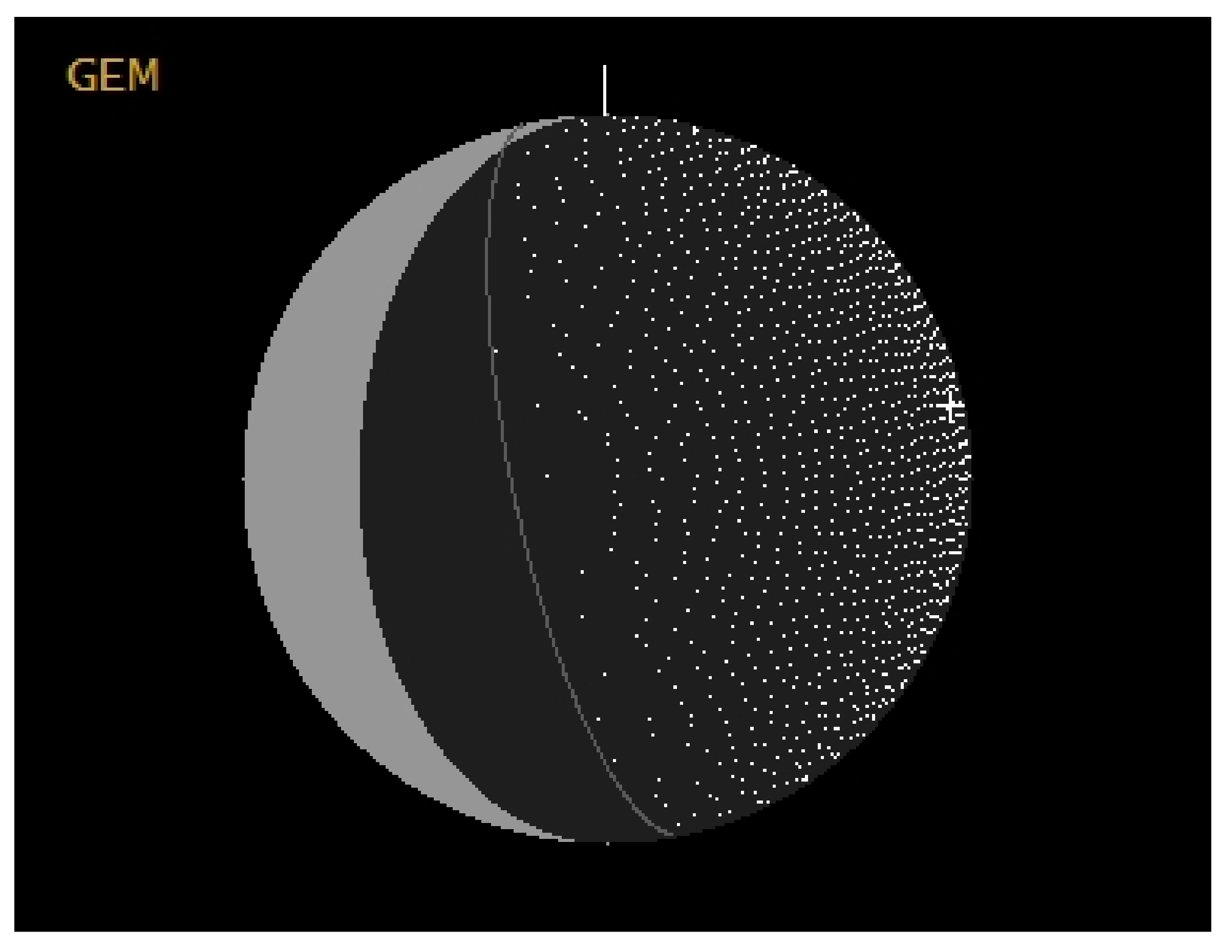

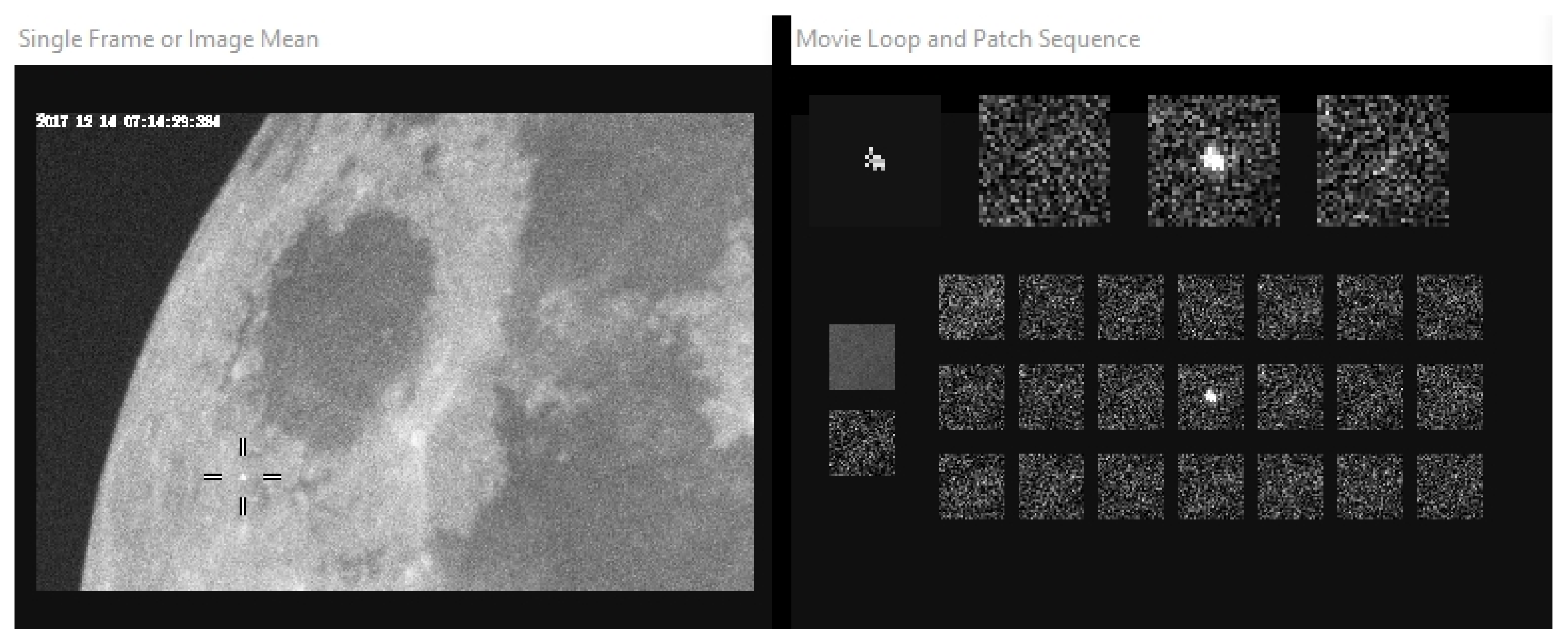
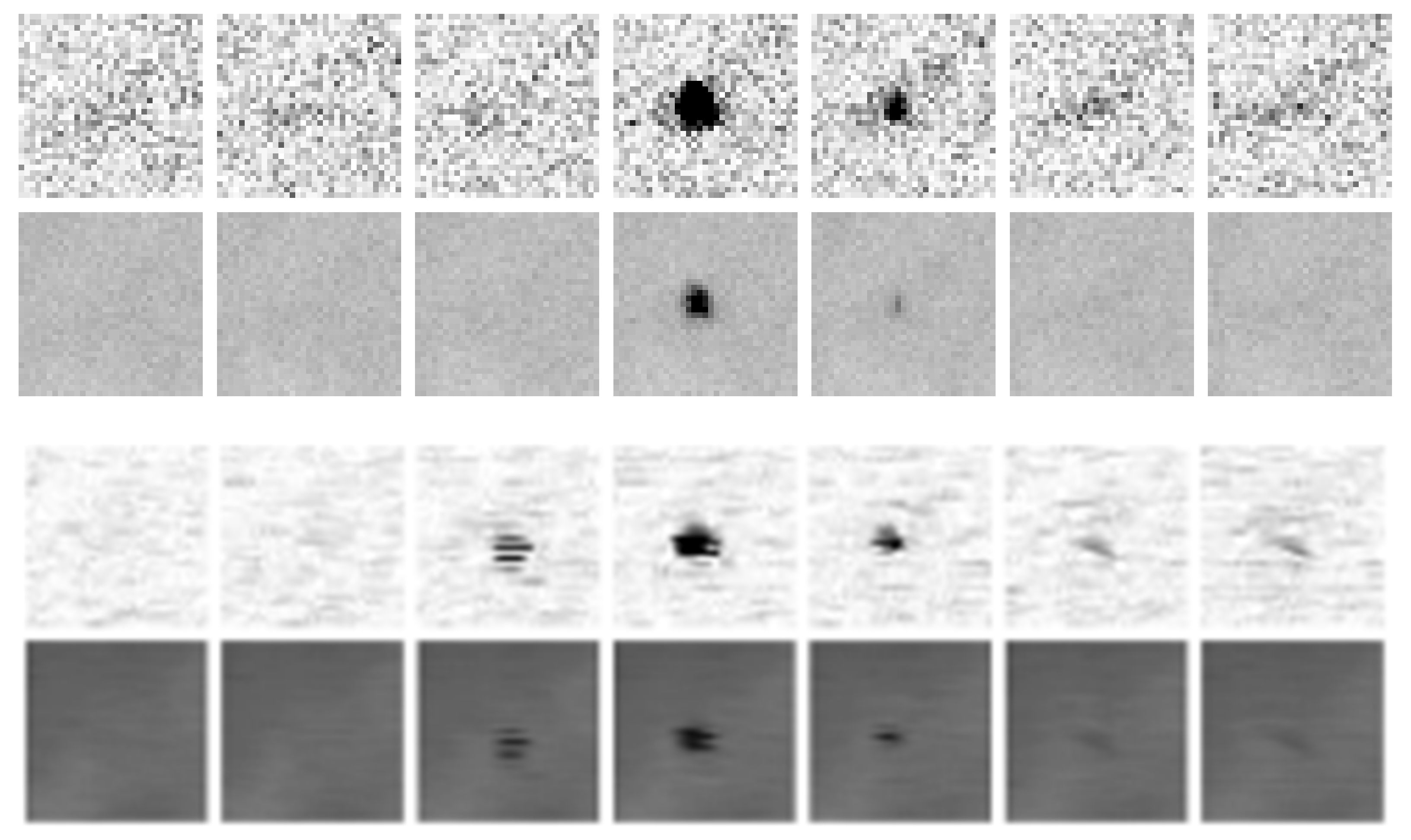


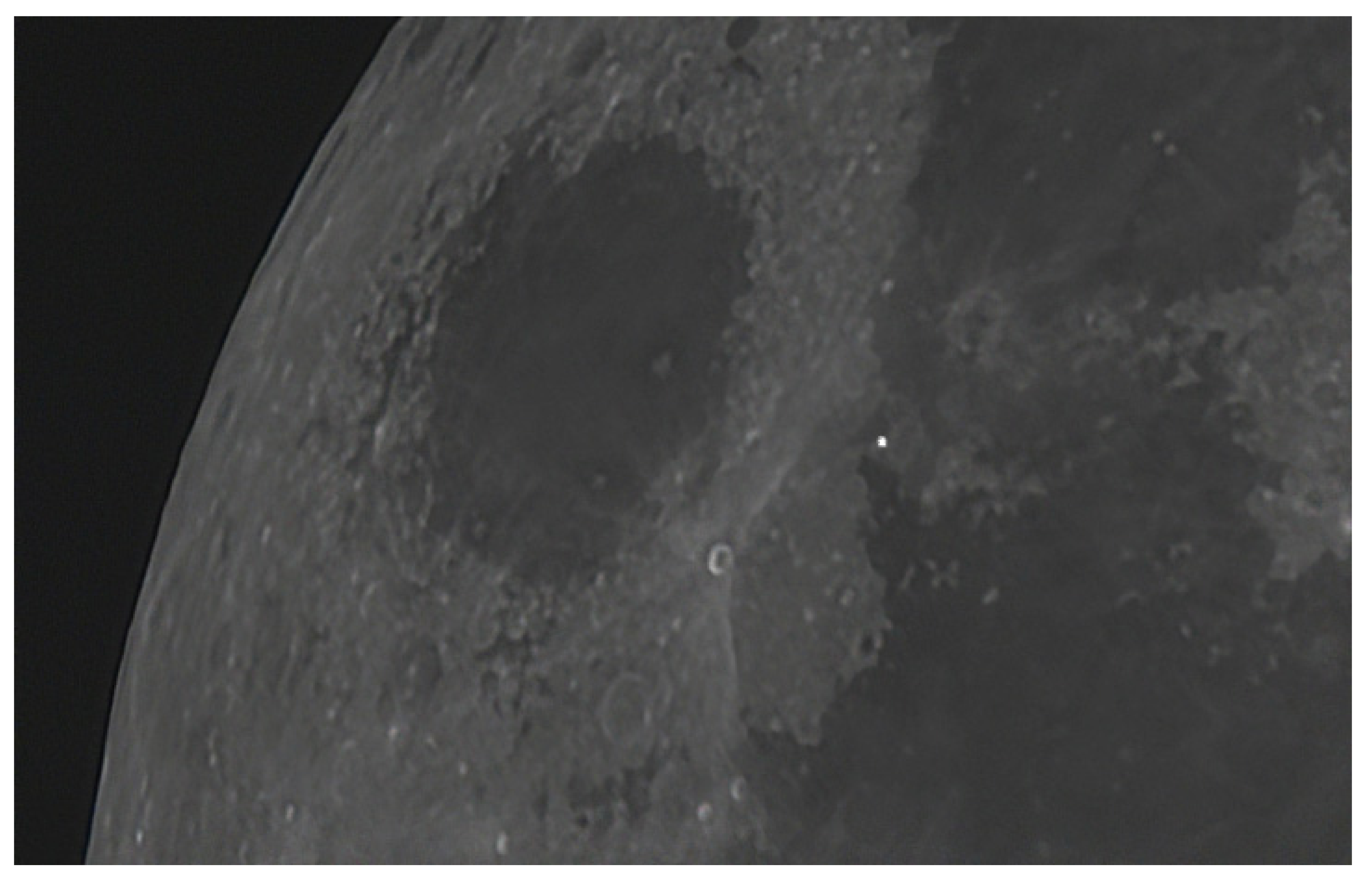
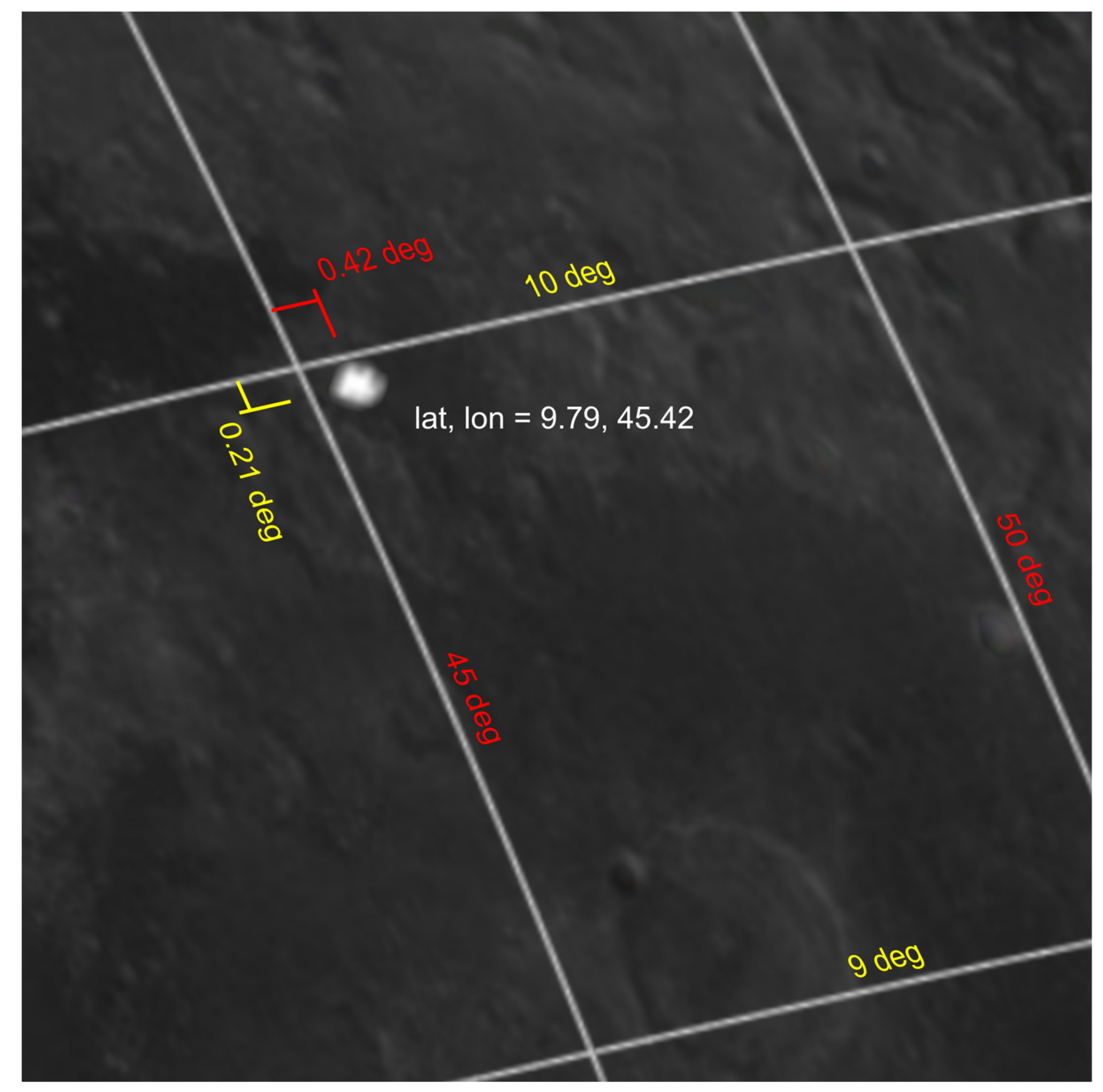

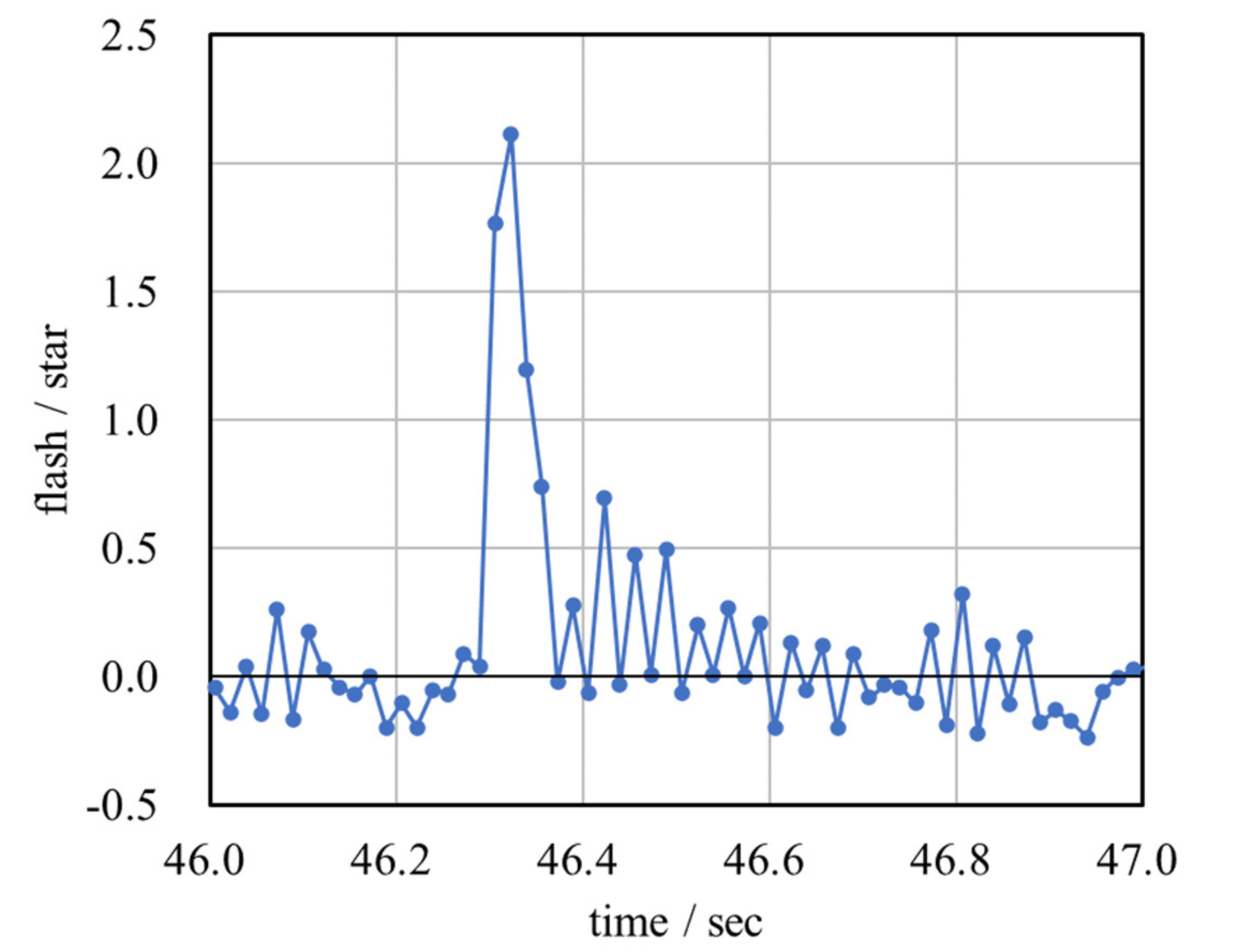


| Flash 1 (Araruna) | Flash 1 (Maceió) | Flash 2 (Maceió) | |
|---|---|---|---|
| Peak V-magnitude | 7.4 | (9.0) | (10.7) |
| Peak R-magnitude | 6.3 | (7.9) | (9.6) |
| Impact energy | 8.7 × 108 J | 1.1 × 109 J | 2.1 × 108 J |
| Meteoroid mass | 1.6 kg | 2.0 kg | 0.38 kg |
| Meteoroid diameter | 10 cm | 11 cm | 6.3 cm |
| Impact angle | 48° | 48° | 56° |
| Crater diameter | 8.4 m | 8.9 m | 5.7 m |
| Parameter | Value | Remarks |
|---|---|---|
| ZHRGEM | 126/h | see Figure S7 |
| HRSPO | 10/h | [11,12,34,37] |
| VGEM | 33 km/s | |
| VSPO | 17 km/s | [4,12,34] |
| VMoon | 2.4 km/s | |
| VEarth | 11.2 km/s | |
| rGEM | 2.6 | IMO Meteor Shower Calendar 2017 |
| rSPO | 3.0 | [12,34] |
| m0GEM | 4.5 × 10−7 kg | [34] |
| m0SPO | 9.8 × 10−6 kg | [12] |
| Emin | 2.1 × 107 J | 1/10 of the impact energy of Flash 2 |
| φ | 42° | for Flash 1 |
| φ | 34° | for Flash 2 |
Publisher’s Note: MDPI stays neutral with regard to jurisdictional claims in published maps and institutional affiliations. |
© 2022 by the authors. Licensee MDPI, Basel, Switzerland. This article is an open access article distributed under the terms and conditions of the Creative Commons Attribution (CC BY) license (https://creativecommons.org/licenses/by/4.0/).
Share and Cite
Duarte Cavalcante Pinto, D.; Yanagisawa, M.; Zurita, M.L.d.P.V.; Caldas, R.A.A.; Domingues, M.; Costa, R.L.; da Rocha Júnior, R.L.; dos Santos Silva, F.D.; Gomes, H.B.; Gomes, H.B.; et al. Analysis of the First Optical Detection of a Meteoroidal Impact on the Lunar Surface Recorded from Brazil. Remote Sens. 2022, 14, 2974. https://doi.org/10.3390/rs14132974
Duarte Cavalcante Pinto D, Yanagisawa M, Zurita MLdPV, Caldas RAA, Domingues M, Costa RL, da Rocha Júnior RL, dos Santos Silva FD, Gomes HB, Gomes HB, et al. Analysis of the First Optical Detection of a Meteoroidal Impact on the Lunar Surface Recorded from Brazil. Remote Sensing. 2022; 14(13):2974. https://doi.org/10.3390/rs14132974
Chicago/Turabian StyleDuarte Cavalcante Pinto, David, Masahisa Yanagisawa, Marcelo Luiz do Prado Villarroel Zurita, Romualdo Arthur Alencar Caldas, Marcelo Domingues, Rafaela Lisboa Costa, Rodrigo Lins da Rocha Júnior, Fabrício Daniel dos Santos Silva, Heliofábio Barros Gomes, Helber Barros Gomes, and et al. 2022. "Analysis of the First Optical Detection of a Meteoroidal Impact on the Lunar Surface Recorded from Brazil" Remote Sensing 14, no. 13: 2974. https://doi.org/10.3390/rs14132974
APA StyleDuarte Cavalcante Pinto, D., Yanagisawa, M., Zurita, M. L. d. P. V., Caldas, R. A. A., Domingues, M., Costa, R. L., da Rocha Júnior, R. L., dos Santos Silva, F. D., Gomes, H. B., Gomes, H. B., de Melo, M. L. D., de Morais Teixeira, L., da Silva Júnior, E. R., Junior, N. D. C., & Herdies, D. L. (2022). Analysis of the First Optical Detection of a Meteoroidal Impact on the Lunar Surface Recorded from Brazil. Remote Sensing, 14(13), 2974. https://doi.org/10.3390/rs14132974









